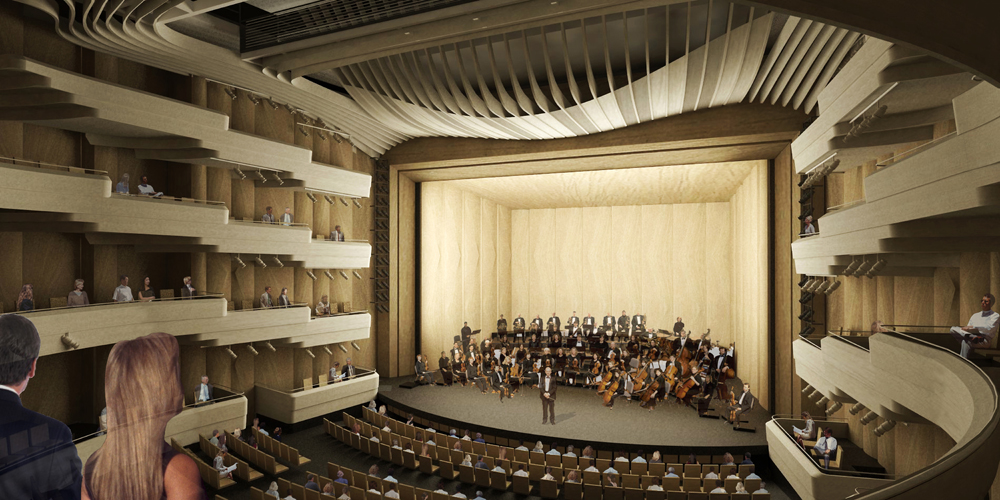Center for the Arts interior designs revealed

With construction of the Center for the Arts at Virginia Tech under way at the corner of Main Street and Alumni Mall, Executive Director Ruth Waalkes and a host of others, including architects at Snøhetta and STV; contractors and construction managers from Holder Construction Company; Virginia Tech personnel; graduate students; and specialty engineering consultants, have turned their attention to the interior.
Renderings of the Center for the Arts interiors are available for viewing for the first time. The team working on the center's interior design and construction are currently sweating details that might never occur to patrons after the doors open and the curtain goes up. Yet, these details can make a big difference to patrons' experiences at the center.
The selection of the fixed seating in the performance hall, for example, included the examination of not only comfort, but also acoustic qualities, repeated-use wear and silence of their moving parts. Earlier in the design process, the team determined that the depth of the first balcony negatively affected acoustics and recommended that 40 seats be removed from the original 1,300 planned for the space. The maximum number of seats, and therefore tickets that could be sold, was reduced to 1,260 without hesitation. No extra ticket would be sold at the expense of the performance hall's acoustics.
Arup, a global engineering and acoustics firm with corporate offices in New York City, is leading the team on matters of acoustics. Arup has worked with major institutions from the Sydney Opera House to the Louvre and the Guggenheim, and is well known for excellence in technical performance engineering. With Arup's guidance, the material, called skin, covering the ceilings and walls of the performance theatre has been tested and specifically selected for its acoustic qualities. Everything in the performance theatre, from the shape of the theatre boxes and balconies to the positioning of lights, has been chosen for its acoustic qualities.
The visual arts exhibition galleries in the Center for the Arts are likewise being carefully considered, but with emphasis on versatility in those spaces. The galleries are being designed and constructed to support not only traditional two-dimensional and three-dimensional art, but also virtual, digital, live, and performance art. Moveable walls, a variety of lighting options, room darkening capabilities, and more will make these galleries an adaptive space for visual arts.
Laboratories and studios are also under development for the center's Institute for Creativity, Arts and Technology. A 3,000-square-foot creative performance lab is part of the center's spaces for the activities of the institute. There, researchers, students, artists, and affiliated pre-kindergarten through 12th grade educators can collaborate on transdisciplinary research projects that will focus on the intersections of art, technologies, and learning.
Spaces dedicated to the institute will be housed in the part of the center that is currently Shultz Hall. The Virginia Tech Corps of Cadets, who have for years taken most of their meals in the un-air conditioned Shultz Hall, will soon be eating in a new, state-of-the-art dining center, which is under construction on Turner Street. The cadet's medallions currently hanging in Shultz will adorn the corps dining room in the new dining center. The new dining center will be open to all and will also provide some space for academic programs of the university.
"With input and guidance from a steering committee, a building committee and numerous groups with technical expertise, which are composed of deans, department heads, faculty, administrators, and graduate students from across campus, I believe we are making sound choices for the Center for the Arts," said Waalkes, "Choices that will translate into a unique world-class center, where performance arts, visual arts, and technology intersect."
The $89 million Center for the Arts will open in fall 2013, but has already begun co-presenting programs. The next Center for the Arts co-sponsored event is the nine-time Grammy Award-winning Emerson String Quartet with the Department of Music on Jan. 28 at the Lyric. Then, on Feb. 12, the center is co-presenting the Roanoke Symphony Orchestra virtuosi group with the New River Valley Friends of the Roanoke Symphony at the Squires Recital Salon. In June and July, the center will present the Vocal Arts and Music Festival (formerly Viva Virginia).




